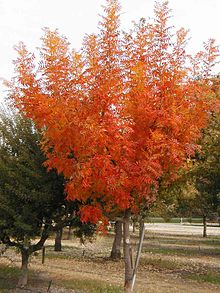- Pistacia chinensis
-
Chinese Pistache 
Pistacia chinensis with autumn colour Conservation status Scientific classification Kingdom: Plantae (unranked): Angiosperms (unranked): Eudicots (unranked): Rosids Order: Sapindales Family: Anacardiaceae Genus: Pistacia Species: P. chinensis Binomial name Pistacia chinensis
L.Pistacia chinensis (English: Chinese Pistache; Chinese: 黄连木 pinyin huángliánmù) is a small to medium-sized tree in the genus Pistacia in the cashew family, Anacardiaceae, native to central and western China. It is hardy, can withstand harsh conditions and poor quality soils, and grows from 9-15 m, exceptionally up to 25 m.[1] The leaves are deciduous, alternate, pinnate, 20-25 cm long, with 10 or 12 leaflets, the terminal leaflet usually absent. The flowers are produced in panicles 15-20 cm long at the ends of the branches; it is dioecious, with separate male and female plants. The fruit is a small red drupe, turning blue when ripe, containing a single seed. This species is planted as a street tree in temperate areas worldwide due to its attractive fruit and autumn foliage.
Contents
Description
Deciduous trees, about 20 m tall; bark dark brown. Petioles minutely pubescent, flattened above; leaf blade imparipinnately compound with 1-13 opposite leaflets; leaf rachis striate, minutely pubescent; petiolule 1-2 mm; leaflet blade lanceolate to ovate-lanceolate, or rarely linear-lanceolate, 5-10 × 1.5-2.5 cm, papery, base oblique, margin entire, apex acuminate or long acuminate, on both sides minutely pubescent along midrib and lateral veins and with prominent venation. Flowers produced before leafing; male inflorescence 6-7 cm, with clustered branches, female inflorescence lax, 15-20 cm, rachis minutely pubescent; floral subtending bracts lanceolate, 1.5-2 mm, minutely pubescent. Pedicels ca. 1 mm, minutely pubescent. Male flowers with 2 lanceolate bracteoles and 2 linear-lanceolate tepals, ca. 1.5 mm; stamens 3-5, filaments less than 0.5 mm, anthers oblong, ca. 2 mm; pistillode absent. Female flowers with 2-4 linear-lanceolate bracteoles and 5 ovate or oblong tepals, 0.7-1.5 × 0.5-0.7 mm; ovary globose, ca. 0.5 mm in diam., glabrous, stigmas thick, red. Drupe obovate-globose, slightly compressed, ca. 5 mm in diam., longitudinally striate in dried condition. Fl. Mar-May, fr. Aug-Nov.[1]
Taxonomy
Synonyms include: Pistacia formosana Matsumura; P. philippinensis Merrill & Rolfe; Rhus argyi H. Léveillé; R. gummifera H. Léveillé.[1]
Some botanists include Pistacia integerrima in this species as P. chinensis ssp. integerrima, with the plants considered here then becoming P. chinensis ssp. chinensis.
Distribution and habitat
Native range on hill and mountain forests on rocky soils; 100-3600 m. It is found in many provinces of China and Taiwan.[1]
Ecology
Chinese Pistache grows best in full sun, being intolerant of shade; it is the most frost-tolerant species of Pistacia, tolerating temperatures down to about -25°C. Yet it is most highly regarded in warm climates. It is planted for its impressive fall colors, which develop at least as far south as Orlando, Florida. In the low-elevation deserts of Arizona, it is the only tree whose leaves turn scarlet in fall.
Uses
Horticulturally, because it is very drought tolerant and can survive harsh environments, it is a popular choice for street tree in urban settings. It is also used as an understock for Pistacia vera.[2] In China the oil from the seeds is used for biodiesel production. The wood is used for production of furniture and yields a yellow dye.
Culture
It is used in classical Chinese Garden design.
References
- ^ a b c d "Pistacia chinensis Bunge, Enum. Pl. China Bor. 15. 1833.". eFloras FOC Vol. 11: 335, 345. 2009. http://efloras.org/florataxon.aspx?flora_id=2&taxon_id=200012703. Retrieved 2009-11-11.
- ^ Ketzel Levine (2003). "Talking Plants: Pistacia_chinensis". NPR. http://www.npr.org/programs/talkingplants/profiles/pistaciachinensis.html. Retrieved 2009-11-11.
Further reading
- Ernest Henry Wilson (1913). A Naturalist in Western China. vol II. London: Methuen & GO. Ltd.. OCLC 459058573. http://www.archive.org/stream/naturalistinwest02wils/naturalistinwest02wils_djvu.txt. Retrieved 2009-11-11.
Categories:
Wikimedia Foundation. 2010.
